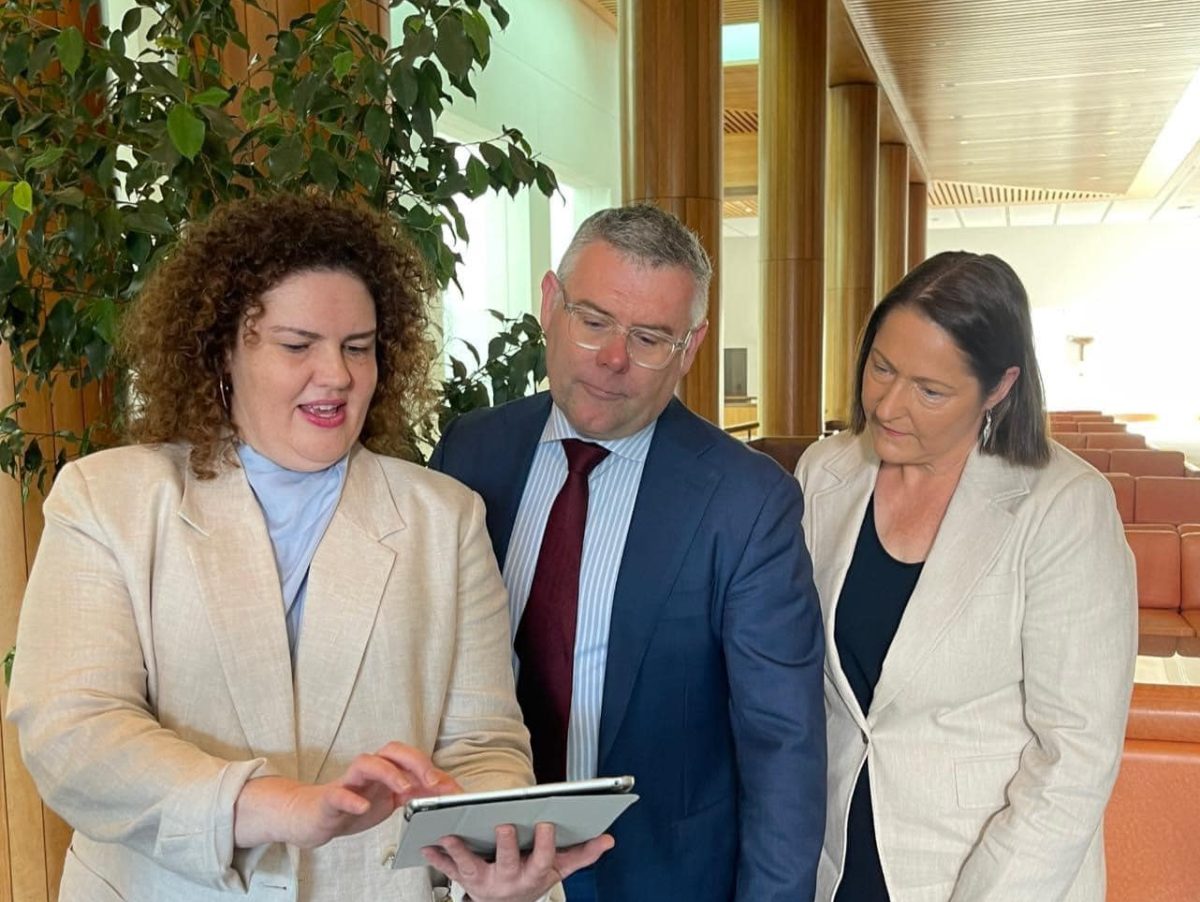
Resilient Building Council CEO Kate Cotter, Minister for Emergency Management Murray Watt and Member for Gilmore Fiona Phillips at the launch of the Bushfire Resilience Rating app at Parliament House. Photo: Fiona Phillips MP.
A world-first app can help South Coast homeowners measure the bushfire resilience of their properties and potentially reduce their insurance premiums.
The Bushfire Resilience Rating app uses a star-rating system and provides homeowners with a customised action plan to make practical, evidence-based bushfire safety improvements to their homes.
As tasks are completed, their home becomes safer and the property’s Bushfire Resilience Rating is updated through the app.
Launched this week at Parliament House by the Resilient Building Council (RBC), the free app aims to help residents better prepare their homes for bushfire risk and is also expected to put downward pressure on insurance premiums.
RBC lead project engineer Dr Ian Bennetts has encouraged people to download the app and “get started today”.
“Bushfires exploit the weakest link in homes, whether they are old or new,” he said.
“There are often many low-cost actions that will improve the home’s resilience immediately, such as draught sealing and moving surfboards and caravans away from the home.
“The more homes upgraded in a community, the less risk of house-to-house fire spread, which can lead to the loss of whole townships.”
Insurance Council of Australia (ICA) CEO Andrew Hall said the app was “an important tool for homeowners in recognising and reducing bushfire risk”.
“It seeks to make it easier for insurers to recognise and make reductions in insurance premiums based on retrofitting to high-risk households, informed by the app’s recommendations,” he said.
“The ICA is also pleased to have partnered with the Resilient Building Council to deliver the Multi-Hazard Resilience Ratings program, which will help insurers, and other industries, recognise effective actions taken by households.”

The new app aims to reduce the risk of bushfire damage to homes across the South Coast. Photo: Lisa Herbert.
The Federal Government’s Disaster Risk Reduction Package provided $3 million to support the RBC’s groundbreaking work, which enables Australians to assess their site-specific risk and take action to improve their bushfire resilience.
More than 1200 households from bushfire-impacted areas helped co-design and trial the app, undertaking actions that resulted in an average 67 per cent reduction in the likelihood of their home igniting in a bushfire.
Member for Gilmore Fiona Phillips said the loss of 795 homes in the Shoalhaven and Eurobodalla in the 2019-2020 bushfires had left a massive toll on people both financially and mentally and left many people wanting to know what they could do to better protect their homes.
“I’m really pleased that this bushfire resilience app was piloted in the Shoalhaven, by people with real lived experiences of bushfires,” she said.
“It’s really given people an important tool to focus on some practical things that can be done to help improve resilience against bushfires.”
Trial participant Sue Josephson also welcomed the app’s release.
“Our home is more than just a building to us – it’s irreplaceable,” she said.
“Our Plan A is to leave early. It’s not worth risking our lives, but we want our home to be there when we return, so we’re doing everything we can to make it as resilient as possible.
“We’ve been sharing the app with everyone we know and giving our neighbours a hand. We’re getting ready together, rather than feeling hopeless.”
The Bushfire Resilience Rating is calculated using the Bushfire House Loss Probability Model, bushfire information, and historical house-loss data.
This is the first scientific model to calculate bushfire building performance.
RBC’s Resilience Ratings were developed to improve the resilience and preparedness of households who have identified bushfire risk and plan ways to mitigate the risk.
The app has been trialled in several fire-prone locations across the country, including in Queensland, NSW and Victoria, and was developed in response to a key recommendation of the Royal Commission into National Natural Disaster Arrangements.
Minister for Emergency Management Murray Watt said that as more people used the app and took action, communities around Australia would be better prepared.
“While governments have a role to play in preparing for this peak period for severe weather, it is a collective responsibility households also share,” he said.
“We commend the Resilient Building Council for their innovative and collaborative solutions to help build national resilience and we are encouraged by discussions through the Hazards Insurance Partnership about insurers supporting this initiative with their customers.”
The next phase of RBC’s Resilience Rating program will be launched by mid-2024, providing expert on-site assessments for integrated bushfire, flood, storm, cyclone, heatwave, and energy-efficiency ratings.
On-site assessors will be able to provide a detailed report on a home and verify Resilience Ratings to support industry initiatives, grants programs or advertising Resilience Ratings when selling or leasing a property.
The Bushfire Resilience Rating app is available at rating.rbcouncil.org.









